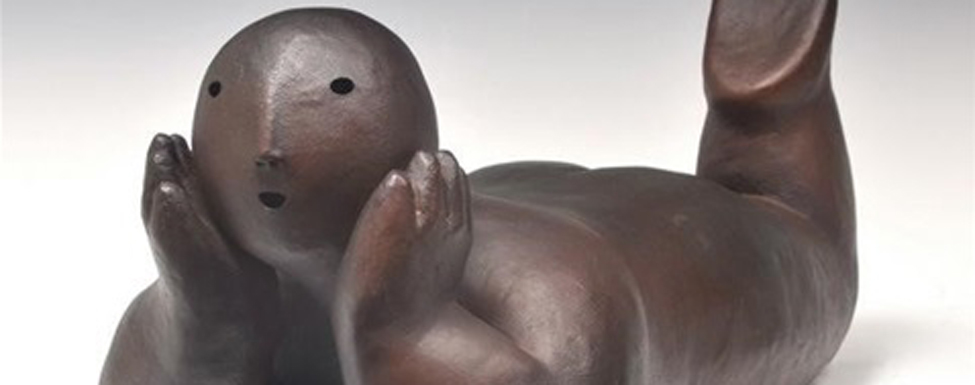Joy Brown
Joy Brown is a presence that looms large on Broadway these days. No, she is not in an SRO play. Rather, nine of the sculptor’s larger-than-life bronze figures, all exuding a Buddha-like serenity, are installed along the thoroughfare.
The exhibition, which has been extended through mid-February, is presented by Morrison Galleries of Kent and the Broadway Mall Association in cooperation with the New York City Department of Parks and Recreation.
The rotund figures are installed from 72nd to 168th Street, greeting pedestrians crossing the street and subway riders emerging from below ground. “It’s a thrill to see how warmly they are being received,” said Brown. “People are always posting pictures of them on Instagram with kids crawling on them. It’s almost like the sculptures are not complete until people interact with them.”
“The Recliners,” located at 166th St. Mitchel Square Park, seem to invite the viewer to lie down beside them on the grass for a leisurely chat—and that chat would even have a starting point. “In New York City life is so fast,” the artist said. “People are living so fast, always on their cell phones. Then here are these big, peaceful, still figures. Sometimes I have little hidden words on them—it’s like a little secret. On the Recliners, I said, ‘Listen, be still, here we are, you and me.’”
The largest of the sculptures, “One Holding Small One,” is on view at the West Sides Arts Coalition on 96th St. “People say, ‘Oh, that is so great, a mother and child,’” she said. “But we are like a child when we are next to it. With all the stuff that is going on with the world and how cut off from nature we are, I wrote, ‘Sweet Mother Earth, holding us all.’”
The large bronze sculptures are a relatively new venture for Brown, who has made her reputation as a clay artist. She grew up in Japan, the daughter of medical missionaries, and apprenticed there in traditional Japanese wood-fired ceramics.
Her work inevitably reflects the Japanese aesthetic instilled through her rigorous apprenticeship with the family of Ichino Toshio, a 13th generation potter in Tamba.
“During that time, I was required to make thousands of cups, never firing one,” she recalled. “Submission to the demands of this process taught me technical skills, disciplined concentration and an understanding of and respect for the clay. It also taught me that my experience while working with clay is just as important as the finished piece. Whether it is a pot or a sculpture, ceramic or bronze, the piece will reflect the spirit in which it was made.”
She carried this sensibility with her to Kent, here she built her studio and constructed a 30-foot-long Japanese-style wood-firing tunnel kiln (anagama). “A year of my work is fired at once, in an intense 24-hour-a-day, week-long firing,” she said. “The resulting warm rich colors and rugged texture are gifts of heat and ash to the clay, bringing life to the unglazed forms.”
In 1998, she co-founded Still Mountain Center, a nonprofit arts organization that fosters East-West artistic exchange.
“In the past, the size of my figures has been limited by the size of my kiln,” she said. About 18 years ago, she started casting some figures in bronze, but was limited in their scope by the cost of reproducing them in metal.
Then, serendipity struck. For the past seven years she has been working in Shanghai several times a year in collaboration with Purple Roof Gallery and Atelier, a small studio and gallery dedicated to supporting contemporary artists. With the support of the gallery, the series of monumental bronze figures has been developed. The Broadway exhibition is its debut in the United States.
“Twenty years ago, I was working with an entrepreneur in Thailand, casting smaller pieces,” she explained. “In 2008, he called from China, and said he was now connected with a Chinese (firm) and would I like to be part of big project.”
Brown had always wanted to cast her figures in a larger format and jumped at the chance. “I took some of my smaller figures and they scaled them up. They made armatures and then I went over and changed them. It was so much fun to work there in that huge workshop. We stayed there and came to really get to know and love those folks over the seven years we’ve been making these big forms.”
The Chinese firm has underwritten the costs of casting, recouping its money only when one has sold. “He’s got $250,000 in production costs on Broadway,” Brown revealed. “It’s a huge gift.”
In all, 13 works have been produced in editions of eight and a second exhibition is on view in China. “It’s like a dual-city exhibition,” said Brown. “These pieces have sisters over there sitting beside the ocean.”
Brown’s work has been exhibited in galleries and museums in the United States, Europe, and Asia, and has been featured in the New York Times, International Herald Tribune, Art News, House and Garden and Ceramics Monthly. She says her work has been influenced by artists as diverse as the creators of pre-Columbian figures, Japanese tomb figures and English sculptor Henry Moore.
To see more of her work please click on the link below. To contact her by email, joy@joybrownstudio.com.


